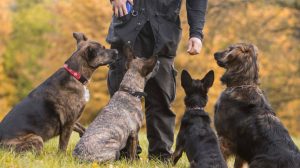Most dogs love to play and romp with other dogs. However, if a dog game becomes a dog fight, you, as the owner, must intervene. It is tricky to recognize whether an intervention is essential or whether the fur noses cannot regulate the situation themselves.

A dog game can sometimes seem very rough; tussling, chasing, raging, rolling, and (playfully) biting. In the guide “Dogs and their play behavior: Different styles,” you can learn more about play among four-legged friends. When a dog game turns into a dog fight, you can usually tell by the clear signs – often even before the first contact between two dogs occurs.
Before the game: Recognize signs of “risk play.”
Before your dog starts playing with another dog, you can try to “read” the situation. Some of the body signals that are not good signs include:
• Frontal, cautious approach with a tense posture
• Staring and lurking with gaze fixation
• Direct barking and growling
• Slow movements and stiffening (extended legs, raised tail, etc.)
• Constant defense against snooping
If you can detect such signals, it is almost sure that no game will develop from them. Regardless of whether your dog is the one driving the antipathy towards the other or the stranger’s dog – never force the two to play (in general, you should never force dogs to make contact with conspecifics). Retreat with your four-legged friend or continue together.
Then a dog game turns into a dog fight.
A balanced and harmonious dog game takes place with constant role reversal. Dogs usually play the part of hunter and prey in a game of hunting or take turns submitting to brawls. The dogs are having fun, are joyful, and respect each other. Even if things can get tense and bites and attacks are suggested, none of the game partners usually get injured. Even playful barking and growling are only for the game. However, it can always happen that the game becomes severe, and you as the holder have to intervene or interrupt the game. Signs that require termination are:
• The dogs fight seriously and bite each other
• A dog has an injury
• A dog howls and is in pain
• A dog flees to the master or mistress (never send the dog back!)
• One dog holds the other down longer
• A dog stiffens and freezes in motion
• One dog keeps shielding, blocking, and cutting off the other
• A dog teases and bullies the other constantly
• A dog shows clear signs of stress and anxiety (curls down, shows soothing signals such as frequent yawns)
Should you notice these and other signs during the game, you can ensure that it is no longer about hilarious dog games. At least one dog is no longer enjoying it, and the game should be ended immediately.
End dog fight: keep calm
If your dog is being bullied, bullied, or attacked by another dog, try recalling your dog to you first. If that doesn’t work, go and get your dog out of the situation. At best, the master or mistress of the play partner also goes to the four-legged friend so that both can be separated in peace. If your dog is very scared or stressed, form a so-called “haven” by squatting down and putting your furry nose between your legs.
Under no circumstances should you yell or yell when you see a dog game escalating into a dog fight – it will worsen the heated situation. If dogs notice that the people around them are panicking, this promotes escalation. You can find more information on intervening in a dog fight, for example, in the guide: “Dog fights in a dog park: How to behave properly.”







